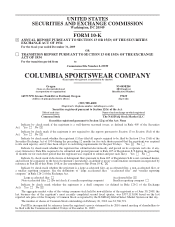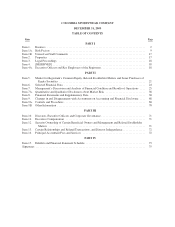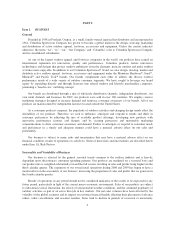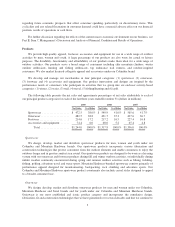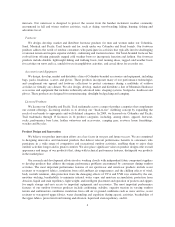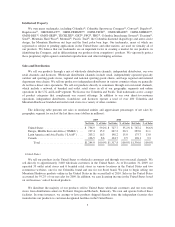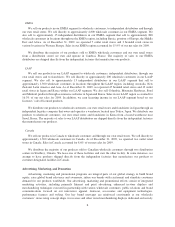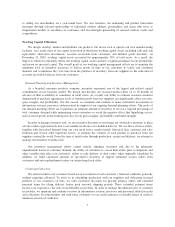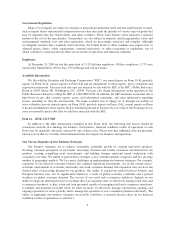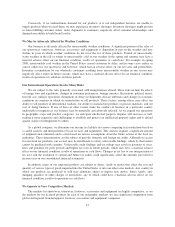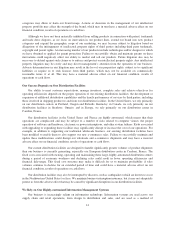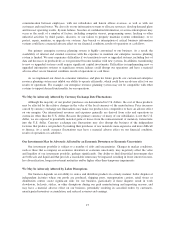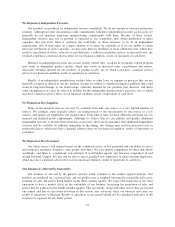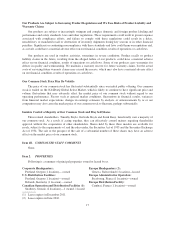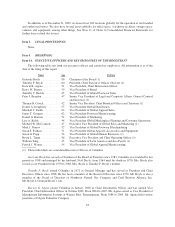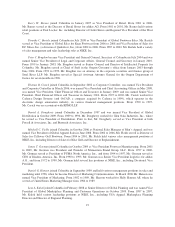Columbia Sportswear 2009 Annual Report Download - page 17
Download and view the complete annual report
Please find page 17 of the 2009 Columbia Sportswear annual report below. You can navigate through the pages in the report by either clicking on the pages listed below, or by using the keyword search tool below to find specific information within the annual report.Our business strategies and related increased expenditures could also cause our operating margin to decline
if we are unable to offset our increased spending with increased sales or gross margins, or comparable reductions
in other operating costs. If our sales decline or fail to grow as planned and we fail to sufficiently reduce our
operating expenses, our profitability will decline. This could result in a decision to delay, reduce, modify or
terminate our strategic business initiatives, which could have a material adverse effect on our financial condition,
results of operations or cash flows.
We continue to expand into international markets where we have little sales or distribution experience and
where our brands are not yet widely known. Expanding into new markets involves, among other things, gaining
consumer acceptance and establishing and protecting intellectual property rights. Attracting superior retail
channel partners and improving the sales productivity of our customers each depend on various factors, including
the strength of our brand names, our ability to design and manufacture innovative products, competitive
conditions, the availability of desirable locations and the negotiation of terms with customers. Future terms with
customers may be less favorable to us than those under which we now operate. Large wholesale customers in
particular increasingly seek to transfer various costs of business to their vendors, such as the cost of lost profits
from promotional activity and product price markdowns, which could cause our gross margins to decline if we
are unable to offset price reductions with comparable reductions in operating costs.
To implement our business strategy, we must continue to modify various aspects of our business, to
maintain and enhance our information systems and operations to respond to increased demand and to attract,
retain and manage qualified personnel. Changes in our business may place an increasing strain on management,
financial, product design, marketing, distribution and other resources, and we may have operating difficulties as a
result. For example, our strategic initiatives, including the implementation of our retail store and e-commerce
strategies, require significant management attention and corporate resources. These business initiatives involve
many risks and uncertainties that, if not managed effectively, may have a material adverse effect on our financial
condition, results of operations or cash flows.
We May be Adversely Affected by a Prolonged Economic Downturn or Economic Uncertainty
We are a consumer products company and are highly dependent on consumer discretionary spending
patterns and the purchasing patterns of our wholesale customers as they attempt to match their seasonal purchase
volumes to volatile consumer demand. In addition, as we have expanded our base of retail stores, we have
increased our direct exposure to the risks associated with volatile and unpredictable consumer discretionary
spending patterns. As global economic conditions continue to be volatile or economic uncertainty remains, trends
in consumer discretionary spending also become unpredictable and subject to reductions due to uncertainties
about the future and credit constraints. Consumer demand for our products may not reach our sales targets, or
may decline, when there is an economic downturn or economic uncertainty in our key markets, particularly
markets in North America and our EMEA region. Our sensitivity to economic cycles and any related fluctuation
in consumer demand may have a material adverse effect on our financial condition, results of operations or cash
flows.
We May be Adversely Affected by Volatility in Global Production Costs
Our product costs are subject to substantial fluctuation based on changes in labor markets in certain Asian
countries, particularly China and Vietnam, interest rates, currency exchange rates, global oil markets, production
capacity at independent factories, and general economic conditions. For example, volatility in global oil markets
has resulted in fluctuating fuel and product prices and caused costs to produce our products through independent
contractors to change, sometimes significantly. Because we price our products in advance and the external cost
changes may be difficult to predict, we may not be able to adjust our pricing structure in a timely manner in order
to remain competitive, which could have a material adverse effect on our financial condition, results of
operations or cash flows. In addition, since the majority of our products are manufactured outside of our principal
sales markets, our products must be transported by third parties over large geographical distances and volatile
fuel costs can result in rapidly changing transportation costs.
10


